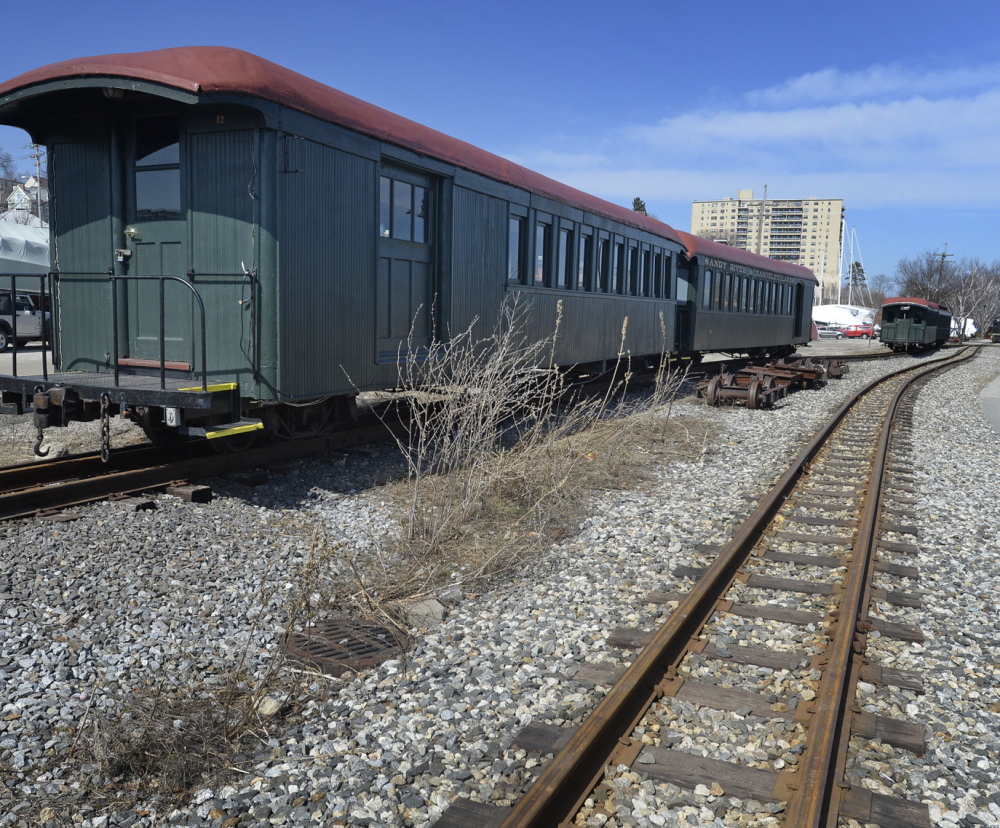The Maine Narrow Gauge Railroad Co. & Museum is moving ahead with plans to leave Portland’s waterfront.
But, like the small passenger train that runs on a 1.5-mile track along the eastern waterfront, the move northwest to Gray will be slow and deliberate. Most of the operations are scheduled to move to Gray in 2016, although rides on the historic passenger cars could be offered in Portland until 2023.
The nonprofit railroad and museum announced in 2011 that it would move to Gray. Since then, its board of trustees has been negotiating to secure a right-of-way to lay a 2-foot-wide rail line from the Gray Plaza Shopping Center on Route 100 – where the group plans to build a 9,500-square-foot museum – along the Portland-Lewiston Interurban Railway corridor. The group would lay about two miles of track.
On Friday, the group will formally receive a deed to use land owned by Central Maine Power Co. for a rail connection needed to move the $6 million project forward.
“This is the key link,” said Donnie Carroll, the railroad’s executive director. “Without this, we wouldn’t be able to run rail lines.”
Beth Humphrey, Gray’s economic development director, said the railroad’s move to town is “really exciting.”
Officials hope the train will boost tourism in town, where nearby attractions include the Maine Wildlife Park, the Spring Meadows Golf Course, antique shops and Pineland Farms in New Gloucester.
“The Narrow Gauge has a great reputation and it’s great for families,” Humphrey said. “It’s another reason Gray can become a destination location. We have a lot of families and it will fit in well here.”
Portland officials have met with the railroad’s representatives in recent months in an effort to keep the attraction in Portland, said Greg Mitchell, the city’s economic development director.
“We’ve done an admirable job of trying to understand their needs,” Mitchell said. “The financial need is great. Our waterfront property is our highest-value real estate.”
The Narrow Gauge Railroad Co. & Museum now draws more than 30,000 visitors a year to Portland’s waterfront, an increase of 25 percent over the past five years, Carroll said.
The museum and railroad are housed in a 7,500-square-foot space in the Portland Company complex on Fore Street, which was sold to a group of investors in August.
Portland has the tourism base to support the railroad, but the location in Gray has many strengths, Carroll said. It’s within an easy ride from Portland but is more central to other population centers, such as the Sebago Lake region, Freeport and Lewiston-Auburn.
Carroll said the railroad is looking to move the museum and have new tracks laid in Gray in 2016. The museum is envisioned to be in a building that would be built next to the Shop N’ Save supermarket. Negotiations with the owner of the Gray Plaza Shopping Center are continuing, Carroll said.
The first floor of the building would house the museum and ticketing operations, while the upstairs would have offices, meeting space and a function room, Carroll said. The train would run through the nearby woods and along a marsh.
“The ride will be different,” Carroll said. “You won’t have the scenic Casco Bay.”
In many ways, the move to Gray is more in line with the historic use of narrow gauge trains.
The trains, called Maine Two-Footers, were originally designed and built in the late 19th century to carry people and products through Maine’s mountainous interior. The five narrow gauge trains that once operated in Maine ran in rural areas on lines that ran through woods and carried passengers, farming materials, lumber and some manufacturing goods, said Sharon Hinkley, president of the Narrow Gauge Board of Trustees.
“There were no narrow gauge trains in Portland,” Hinkley said. “For most of these (rural) communities, it was their link to the outside world.”
The Portland-based nonprofit formed in 1992, when the century-old cars, tracks and equipment were acquired from their former owner in Massachusetts.
It will take time to build up ridership in Gray, Carroll said, so the group hopes to continue offering train rides in Portland until its lease with the state to use the rail line expires in 2023, provided there are enough volunteers.
The nonprofit has only three full-time employees and one part-time person, so it relies on more than 100 volunteers to keep the trains running. Its annual budget is nearly $600,000.
If in 2016 it comes down to operating a train in Portland or Gray, Carroll said, he isn’t sure which way the board will go. But the goal is to move all operations to Gray. It’s just a matter of when the group can raise the money.
“We move at the speed of money,” he said.
Randy Billings can be contacted at 791-6346 or at:
rbillings@pressherald.com
Twitter: @randybillings
Send questions/comments to the editors.




Comments are no longer available on this story